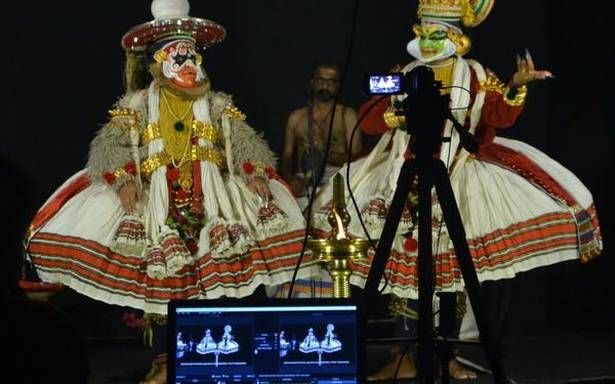Kathakali artistes and aficionados are preparing for a new kind of performing life in the post-pandemic world
Recently, I received a message saying a seat had been ‘reserved’ for me at a Kathakali performance that would be held under Kerala’s strict COVID-19 protocol. It further requested me to send a copy of my vaccination certificate!
That message, and its sender Nandakumar Cheramangalath, represent a nascent wave of art activism in Kathakali where individuals, informal groups, and organisations are trying to fill the vacuum created when the pandemic closed down the traditional platforms. Gone too were the corporate sponsors and the advertisements.
In the pre-pandemic era, it was the hundreds of temples in Kerala that kept the Kathakali artiste busy, especially in the festival season stretching from December to May. Several Kathakali clubs that held programmes every month across the State also helped ensure a decent living for the artistes, especially for the majority who are freelancers without a regular salary. The first lockdown, which came during the peak of the festival season in March 2020, struck an unexpected blow from which the performers and the arts community are yet to recover.
A new wave
It was this crisis that prompted a new wave of activism. Arts organisers across the State are changing the current landscape in different ways — offering monetary help to poor artistes; arranging programmes with a limited audience and streaming them live; trying to equip artistes with the skillsets needed to survive in a tech-savvy world; and educating the audience to appreciate the nuances of this stylised theatre form. One of the first groups to render financial aid is Jeevamrutham@Chettikulangara, an informal group, which has managed to distribute ₹25 lakh in about 15 months, according to a Facebook post. Jeevamrutham, which prefers to keep a low profile, raised the funds from its members both in India and overseas, and has helped more than 400 artistes.
Different approach
Nandakumar, who helms a group of ‘kalibhranthans’ or Kathakali maniacs who organised seven events in less than a year, says his group has a different approach: “We know that what artistes miss the most is their moment on the stage. And that’s what we strived to give them.”
In July last year, even after the first COVID-19 wave had subsided, most of the membership-driven Kathakali clubs had no plans to resume, probably waiting for the situation to stabilise. “That was when we held our first programme in partnership with an arts organisation. We resorted to informal crowdfunding, making use of WhatsApp and Google Pay. Though audience numbers were limited, we got a professional outfit to stream the programme live. The response was gratifying, with people donating from as little as ₹100 to ₹5,000,” says Nandakumar. The seven programmes he organised featured about 75 artistes, and were all streamed live in high-definition over Facebook and YouTube, drawing a big viewership.
There are those who contend that watching Kathakali on a laptop or TV is no substitute for the real thing. Even some artistes aren’t too happy performing to near-empty halls. But from the viewership numbers, it does seem that there is a new class of young viewers comfortable with digital platforms.
Like it or not, streaming is here to stay, says Biju Thekkumpatt of Vazhenkada Kunjunair Memorial Trust, which has been in the forefront of Kathakali organisation for 34 years. Though streaming drives up costs substantially, the upside is that viewership runs into thousands, he adds. “For example, the Dakshayagam Kathakali that we recently hosted at our auditorium for an alumni group of the College of Engineering Trivandrum was watched by nearly 7,000 people, while the capacity of our hall is just about 300.”
Biju says his group’s approach to the pandemic evolved as the situation demanded. “Initially, we had weighed in with monetary help for needy artistes; then we started staging programmes as and when the situation allowed. Now we also offer our auditorium and green room facilities, which are custom-designed for Kathakali, to like-minded organisers for free.”
The new kid on the block, Sanjeevani, takes a more holistic view of the crisis. Its focus is not on financial aid or programmes. Says spokesperson Shailaja Kumar, “Though we have raised ₹8 lakh and have started paying a monthly stipend to 44 artistes for a few months, our long-term focus is on empowering the artistes, improving their knowledge base, and helping them realise their full potential.” For example, Sanjeevani organised a talk by a motivational speaker on how artistes can deploy their skillsets to the best advantage and explore new avenues. It is also conducting conversational English and French classes to help performers communicate with overseas students.
Other promising initiatives include the mudra classes and appreciation courses run by artistes and organisations that aim to transform the lay viewer into a connoisseur. While the COVID-19 situation remains unpredictable, what is certain is that the changes being wrought will transform the arts landscape in the post-pandemic world.
The author, a retired journalist, writes on Kerala’s performing arts.
Source: Read Full Article

